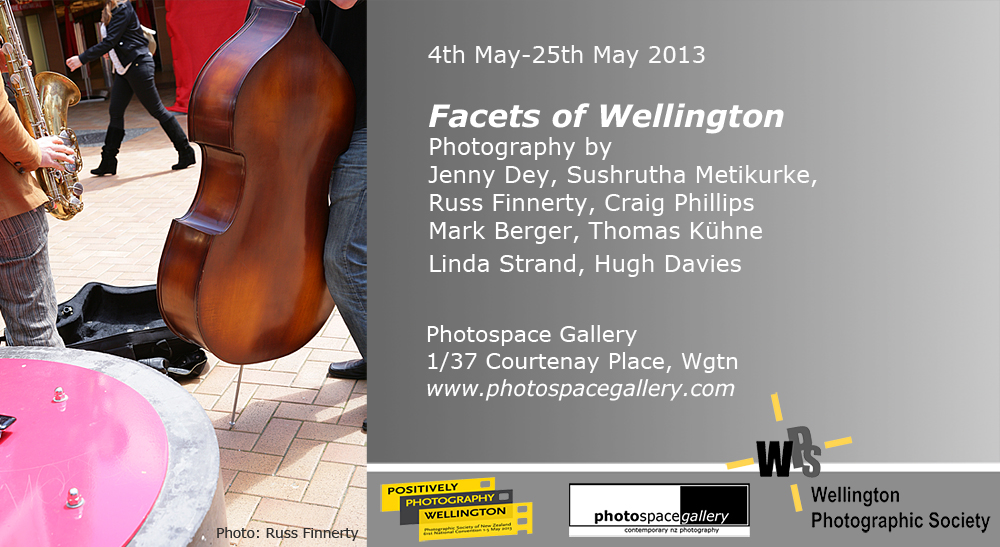Facets of Wellington, 4th May-25th May
This exhibition has been created In association with Wellington Photographic Society and Positively Photography Wellington. The Photographic Society of New Zealand's 2013 conference is in Wellington in May, and this exhibition, curated by James Gilberd of Photospace Gallery, ties into that conference and features the work of eight members of the Wellington Photographic Society, (the hosting organisation).
Photographers' statements:
Photographers' statements:
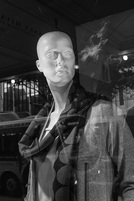
Mark Berger - Wellington faces
They watch 24/7. Almost human, but not quite there. Something is missing.
Who are these genderless, soulless faces looking out onto the streets of Wellington?
Shot and processed as black and white. Printed on Canon Photo Paper Plus Semi-gloss Satin (SG-201) using pigment based inks.
They watch 24/7. Almost human, but not quite there. Something is missing.
Who are these genderless, soulless faces looking out onto the streets of Wellington?
Shot and processed as black and white. Printed on Canon Photo Paper Plus Semi-gloss Satin (SG-201) using pigment based inks.
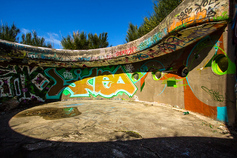
Fort Ballance, Sept 2012
Hugh Davies - Fortress Wellington
European settlers built forts all around the Wellington coast, beginning in the 1880s and continuing to the 1940s, as various invasion scares came and went. Although some of these fortifications have been demolished, the remains of others can be found on ridge tops around the City. Generations of taggers have transformed the otherwise drab, grey concrete of these historic fortifications into colourful displays of their work.
Hugh Davies, a veterinarian by profession and a biologist and photographer by inclination, illustrates this unique and colourful facet of Wellington’s history in this exhibition. More information on Wellington’s forts can be found in Hugh’s book: From the city to the seals, a complete guide to Wellington’s coast, which is available from Photospace gallery.
European settlers built forts all around the Wellington coast, beginning in the 1880s and continuing to the 1940s, as various invasion scares came and went. Although some of these fortifications have been demolished, the remains of others can be found on ridge tops around the City. Generations of taggers have transformed the otherwise drab, grey concrete of these historic fortifications into colourful displays of their work.
Hugh Davies, a veterinarian by profession and a biologist and photographer by inclination, illustrates this unique and colourful facet of Wellington’s history in this exhibition. More information on Wellington’s forts can be found in Hugh’s book: From the city to the seals, a complete guide to Wellington’s coast, which is available from Photospace gallery.
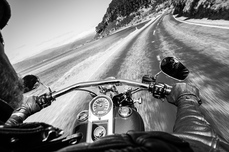
Jenny Dey - From a Harley
I am often invited to go riding on the back of an 1800 Harley Softail, so naturally the Canon 5DMkII is included. Many in the biker community I ride with have described me as “Happy as a pig in mud.” No delicacies there. First Challenge - the weather and available light determines the photo style; sharpness or full immersion impressionism, at least for the start of the ride. Then there are many other constant challenges, such as constantly changing exposure, composing with a full face helmet on, focus (it's often a hope for the best), distance between the bikes in front and behind, battling wind pressure alongside bike speed and how bumpy or smooth the road is. Fuck! What do I hold onto?
I have changed batteries and full cards when doing 100kmph-plus, but changing lenses would be too difficult; it would probably blow the insides of the camera out, as well as being dangerous. Safety at all times – that is the number one rule.
Although I have built up a toolbox of answers for the above challenges, I am never surprised when serendipity makes the best shot.
I am often invited to go riding on the back of an 1800 Harley Softail, so naturally the Canon 5DMkII is included. Many in the biker community I ride with have described me as “Happy as a pig in mud.” No delicacies there. First Challenge - the weather and available light determines the photo style; sharpness or full immersion impressionism, at least for the start of the ride. Then there are many other constant challenges, such as constantly changing exposure, composing with a full face helmet on, focus (it's often a hope for the best), distance between the bikes in front and behind, battling wind pressure alongside bike speed and how bumpy or smooth the road is. Fuck! What do I hold onto?
I have changed batteries and full cards when doing 100kmph-plus, but changing lenses would be too difficult; it would probably blow the insides of the camera out, as well as being dangerous. Safety at all times – that is the number one rule.
Although I have built up a toolbox of answers for the above challenges, I am never surprised when serendipity makes the best shot.
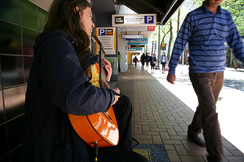
Russ Finnerty - Silent street symphony
Russ Finnerty worked in central Wellington for many years. Like other Wellington workers his lunch breaks often included hurried walks along Lambton Quay, Cuba Mall and Manners St to complete personal business before returning to the office. These streets have a small number of street entertainers. Some are regulars who have occupied the same spot for many years. Others are temporary, often students of music looking to raise funds for further education. And others have less well defined objectives.
Whether regular or temporary, most are ignored by their audience which hurries past immersed in its own tasks.
Russ Finnerty worked in central Wellington for many years. Like other Wellington workers his lunch breaks often included hurried walks along Lambton Quay, Cuba Mall and Manners St to complete personal business before returning to the office. These streets have a small number of street entertainers. Some are regulars who have occupied the same spot for many years. Others are temporary, often students of music looking to raise funds for further education. And others have less well defined objectives.
Whether regular or temporary, most are ignored by their audience which hurries past immersed in its own tasks.
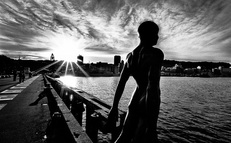
Thomas Kuehne - Wellington figures
In my work, I do not aspire to achieve any kind of fidelity with respect to the original scene, not even in terms of how I perceived it at the time. My choices regarding camera settings, lenses, and post-processing are solely informed by my desire to create a strong end result. I use visual design elements, composition, and framing to create images that are visually appealing but also contain a message or capture an emotion.
By liberating myself from the chains of faithful recording,
I have the chance of – if all the aforementioned pieces come together – create a piece of art.
In my work, I do not aspire to achieve any kind of fidelity with respect to the original scene, not even in terms of how I perceived it at the time. My choices regarding camera settings, lenses, and post-processing are solely informed by my desire to create a strong end result. I use visual design elements, composition, and framing to create images that are visually appealing but also contain a message or capture an emotion.
By liberating myself from the chains of faithful recording,
I have the chance of – if all the aforementioned pieces come together – create a piece of art.
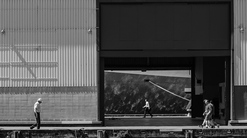
Sushrutha Metikurke - A walk along the waterfront
One of my favourite to-do things in Wellington is to walk along the waterfront, which I do everyday during my lunch break. On good days, the waterfront is a hub of activity. Except one, all other photos in this series were made between noon and 1pm. Even though it's become such a familiar setting, I consider myself lucky that every time I go there with my camera, I come across something out of the ordinary.
I find great pleasure in stepping out with a camera, not knowing what I might end up with when I return. That's one of the great joys of street photography. It's both challenging and rewarding at the same time.
One of my favourite to-do things in Wellington is to walk along the waterfront, which I do everyday during my lunch break. On good days, the waterfront is a hub of activity. Except one, all other photos in this series were made between noon and 1pm. Even though it's become such a familiar setting, I consider myself lucky that every time I go there with my camera, I come across something out of the ordinary.
I find great pleasure in stepping out with a camera, not knowing what I might end up with when I return. That's one of the great joys of street photography. It's both challenging and rewarding at the same time.
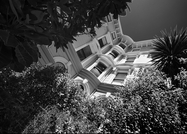
Craig Phillips - Victoria University
My work explores the relationship between Victoria University and the Harbour Capital, Wellington.
Graduates from Victoria University’s law, economics, business and political science schools, have had considerable influence on New Zealand’s past, present and future economic, political and social fabric. Ever since I was a teenager I have been fascinated at how the intellectual energy generated by the university system has explored
the ideals and philosophies that have shaped that fabric.
A broader look at the Victoria environment reveals that past students and academic staff have integrated historical elements of Wellington to provide an environment that links students with tradition in society. This link to tradition demonstrates that exploration and innovation are capable of developing from a traditional environment. By presenting a spectrum of energy and links to the past, the viewer is left with an insight into the place Victoria University has in Wellington’s daily life.
My work explores the relationship between Victoria University and the Harbour Capital, Wellington.
Graduates from Victoria University’s law, economics, business and political science schools, have had considerable influence on New Zealand’s past, present and future economic, political and social fabric. Ever since I was a teenager I have been fascinated at how the intellectual energy generated by the university system has explored
the ideals and philosophies that have shaped that fabric.
A broader look at the Victoria environment reveals that past students and academic staff have integrated historical elements of Wellington to provide an environment that links students with tradition in society. This link to tradition demonstrates that exploration and innovation are capable of developing from a traditional environment. By presenting a spectrum of energy and links to the past, the viewer is left with an insight into the place Victoria University has in Wellington’s daily life.
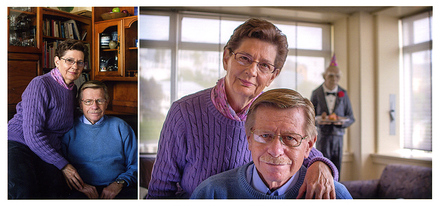
Steve & Linda
Linda Strand - People in my vertical street
This exhibition was a chance for me to extend my photographic learning to portrait taking. I decided to get to know people in my apartment building by taking environmental portraits of some of my neighbours.
Technically, I wanted to keep things simple. I used only one lens – an old 28mm prime. Natural light is abundant in these apartments and was the only lighting I used. The format of combining horizontal and vertical images was chosen to better show both the subjects and the apartments.
This project has been an interesting journey in discovery; of the people I share a building with and of the technical challenges of environmental portraiture.
This exhibition was a chance for me to extend my photographic learning to portrait taking. I decided to get to know people in my apartment building by taking environmental portraits of some of my neighbours.
Technically, I wanted to keep things simple. I used only one lens – an old 28mm prime. Natural light is abundant in these apartments and was the only lighting I used. The format of combining horizontal and vertical images was chosen to better show both the subjects and the apartments.
This project has been an interesting journey in discovery; of the people I share a building with and of the technical challenges of environmental portraiture.

